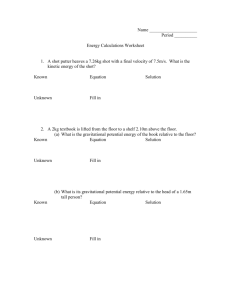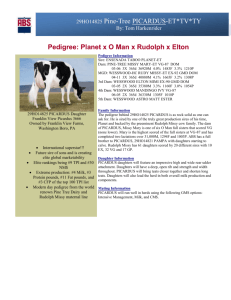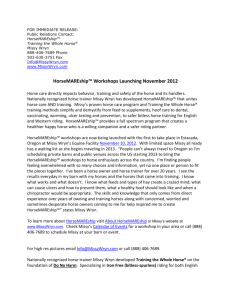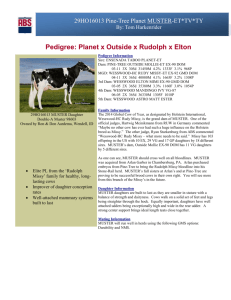Powerpoint presentation
advertisement
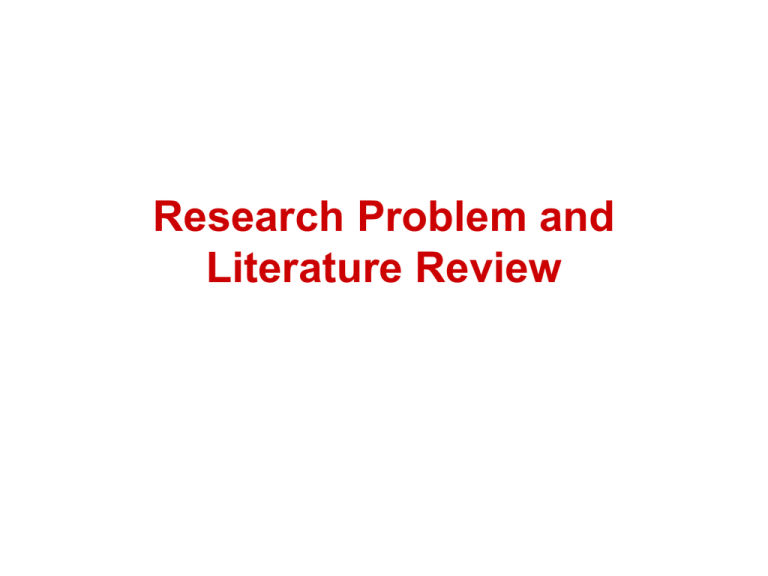
Research Problem and Literature Review Outline 1. Learn how to define a research problem in CS field. 2. Learn how to conduct a Literature Review. How to Find Research Problems • “There were two kinds of scientists: big-bone hunters and small-bone hunters” The biological anthropologist Loren Eiseley • If Eiseley had been a programmer, he would have called this "bottom-up science." http://www.cs.jhu.edu/~jason/advice/how-to-find-research-problems.html How to Find Research Problems • Computer science includes many different kinds of research efforts. You can contribute to one of these 1. The smallest bone in CS – implementation of someone else's work. – Not original but useful to your education and to the field. Example : Implementation of an authentication algorithm. http://www.cs.jhu.edu/~jason/advice/how-to-find-research-problems.html How to Find Research Problems 2. A significant small bone that improves a wellknown technique. – When reading papers, stay on the lookout for such bones. In particular, notice when the author may be making harmful simplifications or arbitrary choices in his/her approach. These are opportunities for you to try something different. . http://www.cs.jhu.edu/~jason/advice/how-to-find-research-problems.html How to Find Research Problems 3. (Medium Size Bone) Along the same lines, you might make a controlled comparison of two or more algorithms – Evaluating them by some objective measure of efficiency or accuracy. – Designing a clean comparison does take thought, and carrying it out is often a lot of work. – Note that quantitative studies of this sort are becoming increasingly important in some areas of CS (e.g., operating systems, machine learning, natural language, algorithms). – Example : Comparison between genetic algorithms and particle swarm optimization http://www.cs.jhu.edu/~jason/advice/how-to-find-research-problems.html How to Find Research Problems 4. Review the existing research in some area. • • Note that this takes a good deal of time to do well, and is not likely to do much for your career unless a lot of people read and cite your lit review. Writing a lit review will make you 1. An expert, able to talk confidently with other researchers in the area; 2. it will give you an idea of the shortcomings of past research; 3. and it may suffice for M.S.E. thesis, or the first part of a Ph.D. thesis. Example “Brain–Computer Interface Technologies in the Coming Decades” This paper focuses on using online brain–signal processing to enhance human–computer interactions; it highlights past and current BCI applications and proposes future technologies that will make significant expansion into education, entertainment, rehabilitation, and human– system performance domains. http://www.cs.jhu.edu/~jason/advice/how-to-find-research-problems.html How to Find Research Problems 5. Build a large program or device of some kind. • • This gets you some name recognition confirms your ability as a software engineer. Ex; King Abdulaziz City for Science and Technology’s SANAM 6. Identify various problems or issues as significant. • • These often represent big bones in the skeleton of the field – problems that arise often, and whose solution makes a difference. How ? • • Get to know some of these problems and the work that's been done on them. If you see how to achieve the first-ever solution, or a better solution, or a different style of solution, that's a big deal. Example : 3D Gaze estimation. (vedio) http://www.cs.jhu.edu/~jason/advice/how-to-find-research-problems.html How to Find Research Problems 7 . Big-bone Research 1. study important papers in your branch of computer science, flip through some conference proceedings to see what people are working on 2. ask: What problems (recognized or unrecognized) are obstructing progress in my field? Can I solve them? If not, can I at least formalize them? Can I prove to my colleagues that solving them would make a difference? http://www.cs.jhu.edu/~jason/advice/how-to-find-research-problems.html LITERATURE REVIEW What is a Literature Review? • A critical, analytical summary and synthesis of the current knowledge of a topic • Compare and relate different theories and findings • Should have a focus/theme to organize the review • Does not need to be exhaustive but should cover significant, academic literature Writing a Literature Review | HCI Process and Theory Missy Harvey | http://www.cs.cmu.edu/~missy/WritingaLiteratureReview.doc Organization of a Review • Brief, but thorough, exploration of past and current work on a topic • Organized thematically, such as different theoretical approaches, methodologies, or specific issues or concepts Writing a Literature Review | HCI Process and Theory Missy Harvey | http://www.cs.cmu.edu/~missy/WritingaLiteratureReview.doc Thematic Organization • Makes it easier to examine – contrasting perspectives – theoretical approaches – Methodologies – Findings • As well as to – analyze the strengths and weaknesses of – and point out any gaps in previous research Writing a Literature Review | HCI Process and Theory Missy Harvey | http://www.cs.cmu.edu/~missy/WritingaLiteratureReview.doc Heart of a Literature Review • May offer new interpretations, theoretical approaches, or other ideas • Must provide a critical overview of the current state of research efforts Writing a Literature Review | HCI Process and Theory Missy Harvey | http://www.cs.cmu.edu/~missy/WritingaLiteratureReview.doc Types of Literature Reviews • Stand-Alone Literature Review Articles – Overview and analysis of the current state of research on a topic or question – To evaluate and compare previous research on a topic – To provide an analysis of what is currently known and to reveal controversies, weaknesses, and gaps in current work—pointing to directions for future research Writing a Literature Review | HCI Process and Theory Missy Harvey | http://www.cs.cmu.edu/~missy/WritingaLiteratureReview.doc Stand-Alone Contents • You can contrast theoretical approaches or conflicting interpretations of findings • Can you find evidence supporting one interpretation vs. another? • Or, can you propose an alternative interpretation that overcomes their limitations? Writing a Literature Review | HCI Process and Theory Missy Harvey | http://www.cs.cmu.edu/~missy/WritingaLiteratureReview.doc Types of Literature Reviews • Research Proposal – Points out current issues and questions concerning a topic – Demonstrates how your proposed research will contribute to the field – Convinces your thesis committee to allow you to pursue the topic of your interest or a grant funding agency to pay for your research efforts Writing a Literature Review | HCI Process and Theory Missy Harvey | http://www.cs.cmu.edu/~missy/WritingaLiteratureReview.doc Types of Literature Reviews • Research Report in the Workplace – Provides the context to which your work is a contribution – In addition to detailing the methods, results, etc. of your research, your report should show how your work relates to others' work Writing a Literature Review | HCI Process and Theory Missy Harvey | http://www.cs.cmu.edu/~missy/WritingaLiteratureReview.doc Structure • • • • • • • Abstract - Brief summary of the contents Introduction - An explanation of the purpose of the study; a statement of the research question(s) you intend to address Literature Review - A critical assessment of the work done so far on this topic—to show how the current study relates to what has already been done Methods - How the study was carried out (e.g. instruments or equipment, procedures, methods to gather and analyze data) Results - What was found in the course of the study Discussion - What do the results mean Conclusion - State the conclusions and implications of the results; discuss how it relates to the work reviewed in the literature review; also point to directions for further work in the area Writing a Literature Review | HCI Process and Theory Missy Harvey | http://www.cs.cmu.edu/~missy/WritingaLiteratureReview.doc What is the Literature? • The "literature" should be written by scientists and researchers for scientists and researchers • They may include: – Academic, scholarly journal articles – Books – – – – Conference Proceedings Dissertations Patents Standards – Technical Reports – Websites and other Internet Resources Writing a Literature Review | HCI Process and Theory Missy Harvey | http://www.cs.cmu.edu/~missy/WritingaLiteratureReview.doc Information Cycle Writing a Literature Review | HCI Process and Theory Missy Harvey | http://www.cs.cmu.edu/~missy/WritingaLiteratureReview.doc Primary Sources • • • • • • • Lab Reports - Records of the results of experiments Field Notes, Measurements, etc. - Records of observations of the natural world Conference Proceedings - Scientists getting together to present their latest ideas and findings Articles of Original Research – Published in peer-reviewed journals Dissertations Patents Internet - Websites that publish the author's findings or research Note: use extreme caution when using the Internet as a primary source … remember, anyone with a computer can put up a website. Writing a Literature Review | HCI Process and Theory Missy Harvey | http://www.cs.cmu.edu/~missy/WritingaLiteratureReview.doc Secondary Sources • Books, articles, and other writings by scientists reporting their work to others • They may be reporting the results of their own primary research or critiquing the work of others • These sources are usually the focus of a literature review: this is where you go to find out in detail what has been and is being done in a field, and therefore to see how your work can contribute to the field. Writing a Literature Review | HCI Process and Theory Missy Harvey | http://www.cs.cmu.edu/~missy/WritingaLiteratureReview.doc Tertiary Sources • Summaries / Introductions - Encyclopedias, dictionaries, textbooks, yearbooks, and other sources that provide an introduction or summary “state of the art” of the research in the subject areas covered. • Databases/Indexes - They are an excellent way of finding books, articles, conference proceedings and other publications in which scientists report the results of their research. Writing a Literature Review | HCI Process and Theory Missy Harvey | http://www.cs.cmu.edu/~missy/WritingaLiteratureReview.doc Working Backwards •Tertiary – Start by finding background information on your topic by consulting reference books for introductions and summaries. – Find bibliographies or citations of secondary and primary sources. Writing a Literature Review | HCI Process and Theory Missy Harvey | http://www.cs.cmu.edu/~missy/WritingaLiteratureReview.doc Work Backwards • Secondary – – – Find books, articles, and other sources providing more extensive and thorough analyses of your topic. Check to see what other scientists have to say about your topic. Find out what has been done and where there is a need for further research. Discover appropriate methodologies for carrying out that research. Writing a Literature Review | HCI Process and Theory Missy Harvey | http://www.cs.cmu.edu/~missy/WritingaLiteratureReview.doc Work Backwards • Primary – Find primary source evidence to support or refute what other scientists have said about your topic – Or posit an interpretation of your own and look for more primary sources – Or create more original data to confirm or refute your thesis – When you present your conclusions, you will have produced another secondary source to aid others in their research Writing a Literature Review | HCI Process and Theory Missy Harvey | http://www.cs.cmu.edu/~missy/WritingaLiteratureReview.doc The Published Literature • Peer Review – When a scientist submits an article to an academic journal or a book manuscript to a publisher, the editors/publishers send copies to other scientists/experts in that field who will review it – The reviewers check to make sure the author has used methodologies appropriate to the topic, used those methodologies properly, taken other relevant work into account, and adequately supported the conclusions, as well as consider the relevance and importance to the field. – A submission may be rejected or sent back for revisions before being accepted for publication. Writing a Literature Review | HCI Process and Theory Missy Harvey | http://www.cs.cmu.edu/~missy/WritingaLiteratureReview.doc The Published Literature • Informal Sharing – In person or online, scientists discuss their projects to let others know what they are up to or to give or receive assistance in their work. – Conferences and online forums (blogs, wikis, etc.) are common ways for these discussions. – Increasingly, scientists are using personal websites to present their work. Writing a Literature Review | HCI Process and Theory Missy Harvey | http://www.cs.cmu.edu/~missy/WritingaLiteratureReview.doc The Published Literature • Conference Presentations – Conferences are a place where scientists read papers, or display at poster sessions to present the results of their work. – Scientists submit a proposal which is reviewed by those sponsoring the conference. – Some databases list conference proceedings along with the author and contact information. Writing a Literature Review | HCI Process and Theory Missy Harvey | http://www.cs.cmu.edu/~missy/WritingaLiteratureReview.doc The Published Literature • Journals – Contain specific analyses of particular aspects of a topic. – The contents are indexed in databases and elsewhere so you can easily find them. Writing a Literature Review | HCI Process and Theory Missy Harvey | http://www.cs.cmu.edu/~missy/WritingaLiteratureReview.doc The Published Literature • Books – Take a longer time to get from research to publication – They can cover a broader range of topics, or cover a topic more thoroughly than articles or conference presentations – Search your library catalog for titles—Librarians can show you how to search for books elsewhere beyond simply Google Books – You can request to borrow titles through the Interlibrary Loan process usually at no cost Writing a Literature Review | HCI Process and Theory Missy Harvey | http://www.cs.cmu.edu/~missy/WritingaLiteratureReview.doc The Published Literature • Dissertations/Theses – Graduate students earning advanced degrees write a substantial piece of original work and then present the results as a thesis or dissertation – Usually, only the library and/or department at the school where the work was done has copies of the dissertation – But once again, the library can usually get you a copy of most dissertations at no cost Writing a Literature Review | HCI Process and Theory Missy Harvey | http://www.cs.cmu.edu/~missy/WritingaLiteratureReview.doc The Published Literature • Websites – In the process of tracking down articles and conference proceedings, you’ll learn who the better known scientists are in your particular field of research – Look for their personal websites to see if you can find additional sources that you haven’t found elsewhere. Writing a Literature Review | HCI Process and Theory Missy Harvey | http://www.cs.cmu.edu/~missy/WritingaLiteratureReview.doc The Published Literature • Reference Sources – Encyclopedias, dictionaries, and other reference sources provide introductions or summaries of the current work in a field – These are usually written by a scientist and/or publisher serving as an editor who invites submissions for articles from experts Writing a Literature Review | HCI Process and Theory Missy Harvey | http://www.cs.cmu.edu/~missy/WritingaLiteratureReview.doc Footnote Chasing • Find key articles in encyclopedias, books, or journals • Look for bibliographies at the end of the articles • Then track down the articles—which may then lead you to more articles that are related Writing a Literature Review | HCI Process and Theory Missy Harvey | http://www.cs.cmu.edu/~missy/WritingaLiteratureReview.doc Writing the Literature Review • • • • • What is the purpose for the literature review and make sure your review specifically addresses your purpose(s). Write as you read, and revise as you read more. Writing a summary of an article when you read it helps you to think more carefully about the article. Having drafts and annotations to work with will also make writing the full review easier since you won’t have to rely completely on your memory or have to keep thumbing back through all the articles. The first draft is for you, so you can tell yourself what you are thinking. Later you can rewrite it for others to tell them what you think. Writing a Literature Review | HCI Process and Theory Missy Harvey | http://www.cs.cmu.edu/~missy/WritingaLiteratureReview.doc General Steps for Writing • Stage One: Annotated Bibliography – As you read articles, books, etc., on your topic, write a brief critical synopsis of each. – Then you will have an abstract or annotation of each source you read. – Later annotations are likely to include references to other works since you will have your previous readings to compare. – But at this point the goal is to get accurate critical summaries of each individual work. Writing a Literature Review | HCI Process and Theory Missy Harvey | http://www.cs.cmu.edu/~missy/WritingaLiteratureReview.doc General Steps for Writing • Stage Two: Thematic Organization – Find common themes in the works you read and organize them into categories. – Usually, each work in your review can fit into one category. – Sometimes a work can fit in more than one. – Write some brief paragraphs outlining your categories, how the works in each category relate to each other, and how the categories relate to each other and to your overall theme. Writing a Literature Review | HCI Process and Theory Missy Harvey | http://www.cs.cmu.edu/~missy/WritingaLiteratureReview.doc General Steps for Writing • Stage Three: More Reading – Based on the knowledge you have gained in your reading, you should have a better understanding of the topic and of the literature. – You have discovered specific researchers who are important to the field or methodologies you were not aware of. Look for more literature by those authors, on those methodologies, etc. – You may be able to set aside some less relevant areas or articles which you pursued initially. – Integrate the new readings into your literature review draft. – Reorganize themes and read more as appropriate. Writing a Literature Review | HCI Process and Theory Missy Harvey | http://www.cs.cmu.edu/~missy/WritingaLiteratureReview.doc General Steps for Writing • Stage Four: Write Individual Sections – For each section, use your annotations to write a section which discusses the articles relevant to that theme. – Focus your writing on the theme of that section, showing how the articles relate to each other and to the theme, rather than focusing your writing on each individual article. – Use the articles as evidence to support your critique of the theme rather than using the theme as an angle to discuss each article individually. Writing a Literature Review | HCI Process and Theory Missy Harvey | http://www.cs.cmu.edu/~missy/WritingaLiteratureReview.doc General Steps for Writing • Stage Five: Integrate Sections – Now that you have the thematic sections, tie them together with an introduction, conclusion, and some additions/ revisions in the sections to show how they relate to each other and to your overall theme. Writing a Literature Review | HCI Process and Theory Missy Harvey | http://www.cs.cmu.edu/~missy/WritingaLiteratureReview.doc Literature Review Literature Review Literature Review Literature Review
